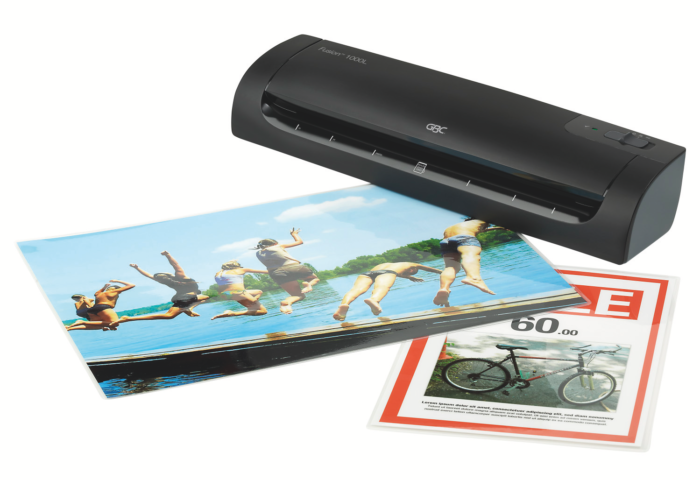Throughout this article, I am going to cover all things lamination. From tips on problem-free lamination, getting our teams favourite machines, and we discuss laminating tips straight from our manufacturer’s mouths!
What does lamination mean?
The term Lamination and what we use it for in the office products industry is when layers of plastic (laminating pouches or laminating rolls) encapsulate paper or photos in order to improve its appearance, strength and resistance.
Apparently, the first proper use of laminating paper may have dated back to the mid-1800s. Thus where damaged documents were repaired with translucent paper. The laminating paper was first widely used in the 1930s and the more uses of plastic lamination were discovered. Consequently, the product became more popular and led to what we now call an office laminator.
Laminating is constantly expanding and manufacturer ranges cover all requirements. From the classic thermal hot pouch laminator and cold laminators to the latest automatic laminators, depending on what uses and needs are required.

If your customers don’t laminate yet… This is why they should!
Paper-based documents undergo various changes when exposed to the air. In order to preserve these documents, adding a plastic laminated layer improves document appearance and can give a more professional finish.
Within the world of ‘office lamination’, major uses include ensuring that documents, photos and banners have a longer shelf life, are weather-resistant and are less likely to be damaged.
In terms of display and signage, laminated sheets can make all the difference. Laminating products completely alter the appearance and agility of a promotional product. As a result, this will improve the usage time and resilience of the documents.
GBC, Fellowes, and Swordfish’s guide to problem-free lamination!
Although laminating is now as common to your customer as using the computer, technical problems do occur. In order to allow your customers to protect their precious and sometimes ‘one-off’ documents being damaged, melted, skewed, wrapped around the laminator rollers along with the pouches, crumpled etc. then wise precautions need to be heeded!
The main problems come from misuse of laminating film pouches and carrier sheets or the laminator heat settings and using unsuitable documents in terms of size, shape or material!
Consequently, manufacturers strive to ensure machines are as user-friendly as possible for the consumer!
In order to minimise these issues and help our customers, Laminator manufacturers GBC, Fellowes, and Swordfish offer their advice on how they can tackle these issues head-on…
GBC’s guide to problem-free lamination
GBC has provided a useful presentation on laminating tips that will help your customers along their lamination process. This is to ensure that user-error problems are kept to a minimum. It highlights how to use their machines correctly and what to avoid whilst using them.
Some of their notable points include:
- Before using laminators, read and understand the machines instruction manual and the user’s guide
- Never feed empty pouches into the laminator
- Turn off the laminator when not in use
- Only use suitable laminating paper products, not foreign objects like wood, material or flowers.
6 tips to save your customers laminator’s from Swordfish
Swordfish have produced the below video as a tool for customers who use their laminating machines. Swordfish offer their 6-step method to problem-free lamination below:
Fellowes ‘frustration-free’ laminating tips!
Another one of our laminator manufacturers, Fellowes offers this helpful laminating guide on making sure that your customer’s lamination is quick, simple and stress-free when using their machines.
Notable tips from Fellowes include:
- Make sure you’re using the right pouch setting on your machine for your chosen thermal laminating pouches.
- Before laminating valuable items do a test run with a similar item in size and thickness.
- Always put something in your pouch – never laminate a completely empty pouch.
- Trim laminated materials after laminating, not before. Be sure to check out the full range of Fellowes Trimmers and Guillotines – ideal for cutting and trimming your laminated materials.
- Experiment with different micron thicknesses and pouch finishes – it can make a real difference to the finished result
Laminator Reviews from our Sales Team…
We conducted some research internally with our Sales Team. We asked our Product Experts which laminating machines they believe are the best in terms of usability, speed and finish. The results were varied:
Phill Aubert – Sales Team
“My favourite laminator by far is the GBC Foton 30. It’s difficult to compare to any other laminator because it is the first automatic laminator of it’s kind. With faster-laminating speed and it is so easy to use. It’s like comparing lighting a match to rubbing two sticks together for fire!”
Adrian Shaw – Sales Team
“I like the Leitz iLam Touch 2 Turbo A3 pouch laminator we use in the office as you only have to switch it on and after a 1 minute warm-up time it is ready to laminate. You don’t need to adjust the temperature to the thickness of the pouch, it simply adjusts the speed at which it pulls the pouch through.”
Mark Smith – Sales Team
“My favourite is the Fellowes Voyager that we use in the office. It is a heavy-duty beast but uses a belt rather than a roller to laminate and so is very reliable, as well as user-friendly. It is also one of the few models which you can actually take the top off in order to access the belt to free jams should they occur.”